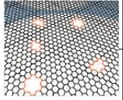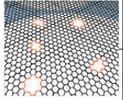
Another area in which incremental nanotechnology is poised to make a major contribution to human welfare through increasing control of the atomic structure of bulk materials is Supplying Clean Water Globally. Two recent reports use slightly different chemistries to achieve similar results: water desalination and purification.
KurzweilAI describes research in which gallium ions and oxidative etching were used to create sub-nanometer diameter holes in single layer graphene membranes “Selective nanopores in graphene dramatically improve desalination and purification“:
A team of researchers at MIT, Oak Ridge National Laboratory, and in Saudi Arabia succeeded in creating subnanoscale pores in a sheet of graphene, a development that could lead to ultrathin filters for improved desalination or water purification. Their findings are published in the journal Nano Letters. [abstract]
The new work, led by graduate student Sean O’Hern and associate professor of mechanical engineering Rohit Karnik, is the first step toward actual production of such a graphene filter.
Making these minuscule holes in graphene — a hexagonal array of carbon atoms, like atomic-scale chicken wire — occurs in a two-stage process. First, the graphene is bombarded with gallium ions, which disrupt the carbon bonds. Then, the graphene is etched with an oxidizing solution that reacts strongly with the disrupted bonds — producing a hole at each spot where the gallium ions struck. By controlling how long the graphene sheet is left in the oxidizing solution, the MIT researchers can control the average size of the pores. …
The permeability of such graphene filters, according to computer simulations, could be 50 times greater than that of conventional membranes, as demonstrated earlier by a team of MIT researchers led by graduate student David Cohen-Tanugi of the Department of Materials Science and Engineering. But producing such filters with controlled pore sizes has remained a challenge. The new work, O’Hern says, demonstrates a method for actually producing such material with dense concentrations of nanometer-scale holes over large areas. …
With this technique, the researchers were able to control the filtration properties of a single, centimeter-sized sheet of graphene: Without etching, no salt flowed through the defects formed by gallium ions. With just a little etching, the membranes started allowing positive salt ions to flow through. With further etching, the membranes allowed both positive and negative salt ions to flow through, but blocked the flow of larger organic molecules. With even more etching, the pores were large enough to allow everything to go through.…
In similar research, also reported by KurzweilAI, a micrometer-thick laminate of graphene oxide hosts a network of nanocapillaries that blocks all solutes with hydrated radii greater than 0.45 nm “New multilayer graphene structure allows ‘ultraprecise,’ ‘ultrafast’ water filtering“:
University of Manchester researchers have taken another key step toward a seawater filter: they’ve developed one-atom-wide graphene-oxide (GO) capillaries by building multilayer GO membranes (laminates).
As described in Science [abstract], these new laminates allow for “ultraprecise” selection of molecules that can go through the filter and “ultrafast” flow of water.
The new GO filters have an “astonishingly” accurate mesh that allows them to distinguish between atomic species that are only a few percent different in size. The filters block passage of ions (charged atoms) that are larger than 9 angstroms (.9 nanometers).
“The water filtration is as fast and as precise as one could possibly hope for such narrow capillaries,” said study co-author Rahul Nair. “Now we want to control the graphene mesh size and reduce it below nine Angstroms to filter out even the smallest salts like in seawater. Our work shows that it is possible.”
“Our ultimate goal is to make a filter device that allows a glass of drinkable water made from seawater after a few minutes of hand pumping,” added study co-author Irina Grigorieva. “We are not there yet but this is no longer science fiction.”
As the remainder of the article explains, graphene oxide is hydrophobic (repels water) but a water layer only one molecule thick will flow rapidly through narrow capillaries of graphene. It turns out that a quick and easy way to make graphene oxide capillaries with a one-atom-wide diameter is to pile layers of graphene oxide together, forming a very strong laminate a micrometer thick. These laminates are vacuum-tight when dry, but when immersed in water a network of nanocapillaries forms that accept only species smaller than 0.9 nm in diameter, and at rates thousands of times faster than allowed by diffusion. The diameter of a water molecule is about 0.28 nm. The diameter of a sodium ion is about 0.23 nm and of a chloride ion about 0.33 nm, so salt as well as water will pass through the current laminates, although larger molecules would be excluded. The authors seem confident that they can make the capillaries small enough to exclude salt ions but pass water molecules.
The quick and inexpensive separation of pure water from seawater or other sources would be easiest with a one-atom-thick membrane perforated with large numbers of precisely placed atomically precise pores just large enough to efficiently pass water molecules and block all other atoms, molecules, and ions. In the absence of a method for atomically precise manufacturing of such a material, the above two research collaborations succeeded in using current nanotechnology of bulk materials to place large numbers of nanometer-scale pores controlled to near atomic precision in bulk nanoscale materials. Either or both of these approaches, or some similar approach, may take us a long way to meeting all or most of our ultrafiltration and purification needs, but when we develop atomically precise manufacturing we will have simpler and easier access to filters designed for the exact purpose needed.
—James Lewis, PhD
